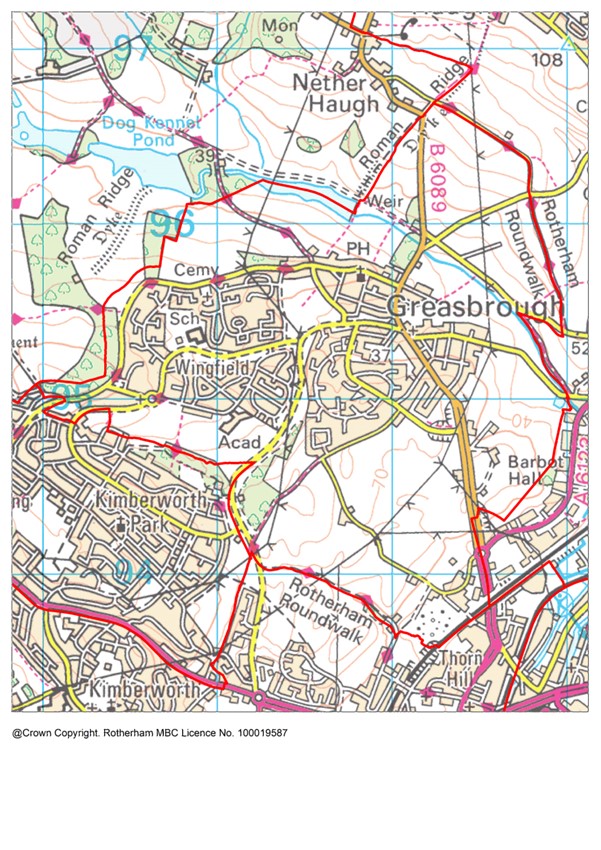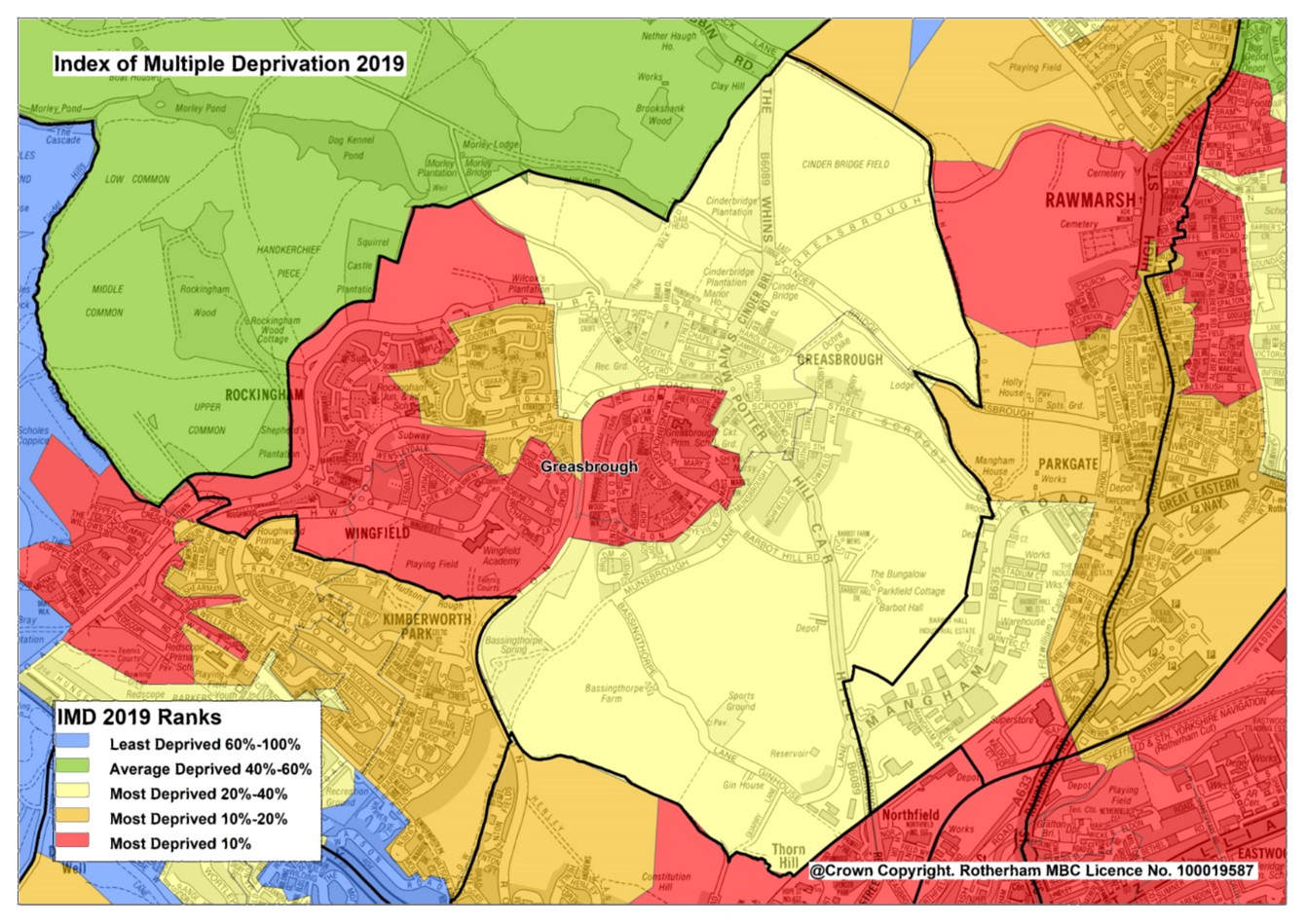Ward profile
Employment, Benefits and Pension
Crime and Anti-social Behaviour

Description
Greasbrough ward lies in the northwest of the borough, with a population of 7,786 (2021 census).
The ward is represented by two members of the Council.
Greasbrough covers the mainly council housing areas of Rockingham, Wingfield and Munsbrough. A high proportion of council homes in the ward are flats. The main area of private housing is Greasbrough which is an old village with some terraced housing.
On the northern and eastern fringes of Greasbrough is open countryside.
Most of the open land in the southeast is designated for the new Bassingthorpe housing development in the longer term.
Find out more about Greasbrough on Rotherham Data Hub
Population by Age
The population of Greasbrough ward has decreased since 2011 in contrast to the increasing borough population. The age structure of the population is older than the Rotherham average, with the percentage aged 45+ being 52.6% compared to the Rotherham average of 46.4%.
|
Age |
Ward Population |
Ward Percentage |
Rotherham Percentage |
|
Age 00-15 |
1092 |
14.03 |
18.89 |
|
Age 16-24 |
774 |
9.94 |
9.60 |
|
Age 25-44 |
1823 |
23.41 |
25.09 |
|
Age 45-64 |
2317 |
29.76 |
26.76 |
|
Age 65+ |
1780 |
22.86 |
19.66 |
|
Total |
7786 |
100.00 |
100.00 |
Ethnicity
Greasbrough ward is among the 80% of wards in Rotherham where the white British population exceeds 90%. However, the 2020 School and Pupil Census shows ethnic minority pupils accounting for over 10% of the school age population.
|
Ethnicity |
Ward % |
Rotherham % |
England % |
|
White British |
94.20 |
88.30 |
74.70 |
|
Asian/Asian British |
0.80 |
5.30 |
9.60 |
|
White Other |
1.60 |
2.80 |
6.30 |
|
Mixed/multiple |
1.70 |
1.40 |
3.00 |
|
Black/Black British |
1.10 |
1.10 |
4.20 |
|
Other |
0.50 |
1.10 |
2.20
|
Housing
Total dwellings (2021 Census) - 4241
Total dwellings (2011 Census) - 3992
Change since 2011 (%) – 6.20
Number of households
Households (2021 Census) - 3956
Households (2011 Census) - 3992
Change since 2011 (%) - -0.90
Population Density (no. of residents per square Kilometre) 2021 Census
Ward – 1493.50
Rotherham - 927.70
Employment, Benefits and Pensions
In Greasbrough ward the total claimant count in July 2023 is 315, which is 6.5% of the working age population. This is higher than the Rotherham average where the claimant count is 4.3% of the working age population.
Greasbrough ward has a high proportion of workplace employment in manufacturing, education and motor trades. The number of jobs in the ward is equivalent to 53% of the local working age population.
General Health and Disability
In Greasbrough 37% are in very good health, and 2.5% are in very bad health. In comparison, in Rotherham 44.2% are in very good health and 1.6% are in very bad health.
According to Census 2021, in Greasbrough ward, 27.1% of the population are considered to be disabled under the Equality Act 2010, compared to 21.1% in Rotherham and 17.3% in England. The definition of disability in Census 2021 was: People who assessed their day to day activities as limited by long-term physical or mental health conditions of illnesses are considered disabled. Thus definition of a disabled person meets the harmonised standard for measuring disability and is in line with the Equality Act (2010).
Life expectancy
In the period 2016-2020, Greasbrough ward's life expectancy at birth for females is 78.4 years and for males is 74 years. This is worse than the England average. In comparison, Rotherham's life expectancy for females is 81.3 years and for males is 77.6 years.
Disease and lifestyle
In the 2016-20 time period, the mortality ratio for deaths from strokes in Greasbrough ward is 87. This is similar to England. In comparison, the lowest mortality ratio for stroke deaths in a Rotherham ward is 56.7 in Aston & Todwick ward and the highest ratio is 185.8 in Rother Vale ward.
In the 2016-20 time period, the mortality ratio for deaths from respiratory disease in Greasbrough ward is 189. This is worse than England. In comparison, the lowest mortality ratio for deaths from respiratory disease in a Rotherham ward is 79.9 in Bramley & Ravenfield ward and the highest ratio is 209.1 in Rother Vale ward.
In the 2016-20 time period, the mortality ratio for deaths from coronary heart disease in Greasbrough ward is 107.7. This is similar to England. In comparison, the lowest mortality ratio for deaths from coronary heart disease in a Rotherham ward is 76.2 in Aston & Todwick ward and the highest ratio is 152.1 in Rotherham East ward.
In the 2016-20 time period, the mortality ratio for deaths from circulatory disease in Greasbrough ward is 107.5. This is similar to England. In comparison, the lowest mortality ratio for deaths from circulatory disease in a Rotherham ward is 73.5 in Aston & Todwick ward and the highest ratio is 141.9 in Rother Vale ward.
In the 2016-20 time period, the mortality ratio for deaths from cancer in Greasbrough ward is 128.2. This is worse than England. In comparison, the lowest mortality ratio for deaths from cancer in a Rotherham ward is 94.2 in Aston & Todwick ward and the highest ratio is 152.1 in Rother Vale ward.
Obesity
In Greasbrough ward (for the time period 2019/20-2021/22) the percentage of children in Reception (aged 4-5 years) classified as overweight or obese is 24.3%. This is worse than the England average. The percentage of children classified as obese (including severe obesity) is 10.8%. This is worse than the England average. In Rotherham overall (for comparison) the percentage of children aged 4-5 years classified as overweight or obese is 25.1% and the percentage classified as obese (including severe obesity) is 11.4%.
In Greasbrough ward (for the time period 2019/20-2021/22) the percentage of children in Year 6 (aged 10-11 years) classified as overweight or obese is 42.1%. This is worse than the England average. The percentage of children classified as obese (including severe obesity) is 26.3%. This is worse than the England average. In Rotherham overall (for comparison) the percentage of children aged 10-11 years classified as overweight or obese is 38.8% and the percentage classified as obese (including severe obesity) is 25.1%.
Education
According to Census 2021, in Greasbrough ward 28.3% of residents aged 16 or over have no qualifications, and 16.4 % are qualified to level 4 or above. In comparison 23.4% in Rotherham have no qualifications and 23.1% are qualified to level 4 or above.
For Greasbrough ward in 2023, there was a total of 69 pupils at the end of key stage 2, of which 68.1% were disadvantaged compared to 54.5% for Rotherham overall. The percentage of pupils in the ward achieving the expected standard in Reading, Writing and Maths was 56.5%, compared to 54.5% in Rotherham and 59% nationally.
For Greasbrough ward in 2023, there was a total of 68 pupils at the end of key stage 4, of which 83.8% of pupils were disadvantaged, compared to 53.4%% in Rotherham overall. The average Attainment 8 score for the ward was 48.4, compared to 43.2 in Rotherham and 46.2 nationally.
Crime and Anti-Social Behaviour (ASB)
Levels of recorded crime and anti-social behavior in Greasbrough ward are higher than the Rotherham average.
In Greasbrough ward in 2021 there were a total of 1,216 recorded crimes. This equates to 156 recorded crimes per 1,000 population compared to 110 per 1,000 population for Rotherham.
In Greasbrough ward in 2021, there were a total of 177 recorded incidents of anti-social behaviour. This equates to 23 recorded incidents per 1,000 population, compared to 19 per 1,000 population for Rotherham.
Index of Deprivation
Greasbrough ward has a rank of 4 out of 25 wards in Rotherham and is in Decile 2. Of the 25 wards in Rotherham, 5 are in the top 20% most deprived in the country (deciles 1 and 2). The top 3 most deprived wards in Rotherham are Rotherham East, Dalton & Thrybergh and Maltby East.
Deprivation in Greasbrough ward is above the borough average and in most of the ward is also above the national average. The three neighbourhoods of Munsbrough, Wingfield and Rockingham West are within the most deprived 10% in England.
In Greasbrough ward, the proportion of all children aged 0-15 living in income deprived families is 28.6% and the proportion of those aged 60 or over who experience income deprivation is 21.5%. The ward with the highest proportion of children aged 0-15 living in income deprived families is Dalton & Thrybergh ward at 39.1%. The ward with the highest proportion of those aged 60 and over who experience income deprivation is Rotherham East ward at 36.9%.

Data Sources
Data sources contained within this document include:
Population - ONS Census data via NOMIS Ethnicity - ONS Census data via NOMIS
Religion - ONS Census data via NOMIS
Housing - ONS Census data via NOMIS
Households - ONS Census data via NOMIS
Unemployment claimants aged 16-64 - ONS Claimant Count via NOMIS
Types of employment - Business Register and Employment Survey via NOMIS
General Health - ONS Census data via NOMIS
Disability - ONS Census data via NOMIS
Life expectancy at birth - Public Health England Fingertips
Causes of death - Public Health England Fingertips
Overweight and obesity in children - Public Health England Fingertips
Highest level of education - ONS Census data via NOMIS
Key Stage 2 and Key Stage 4 attainment - RMBC Children & Young People's Services
Index of Multiple Deprivation - Ministry of Housing, Communities and Local Government Community assets map - OpenStreetMap via TomTom/Microsoft Corporation
Access to green space - Green Space Index 2023 commissioned by The Ordinance Survey and undertaken by The Fields in Trust
Crime data - www.police.uk
